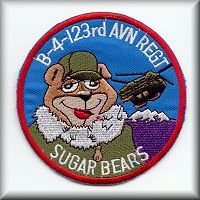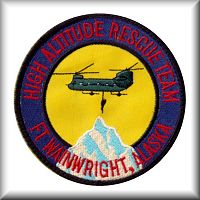 |
|
 |
| 90-00182 |
|
 |
|
 |
| 90-00182, Boeing D model kit number M3334, was a CH-47D helicopter. The U.S. Army acceptance date was 30 November 1990 at 2,847.6 aircraft hours. As of 18 March 2003, 90-00182 had accumulated 1,989.9 D model hours and 4,828.9 total aircraft hours. 90-00182 was a conversion from the original C model Chinook 74-22272. On 14 December 1989, 90-00182 was inducted into the D Model program. The conversion completion date was 23 November 1990. On 7 December 1990, 90-00182 was initially assigned to the unit that would eventually become B Company - "Sugar Bears North", 4th Battalion, 123rd Aviation Regiment, located at Fort Wainwright, Alaska. Fort Wainwright was the former historic Ladd Field of World War Two era fame. B Company was the former C Company, 228th Aviation Regiment (16 October 1987 - 24 June 1994). C Company was the former 242nd Assault Support Helicopter Company (ASHC) - "Muleskinners" (located in Alaska November 1971 through 16 October 1987). When United States involvement in the Vietnam conflict ended, 242nd ASHC was relocated from the Republic of Vietnam (RVN) to Alaska. The aviation unit in Alaska at the time was designated the 236th ASHC, 19th Aviation Battalion (April 1971 - November 1971). When the 242nd ASHC relocated to Alaska and reformed, the unit name changed from "Muleskinners" to "Sugar Bears" and the unit designation went from the 236th ASHC to the 242nd ASHC. At some point, the unit was split into two companies. One company remained in Alaska and became known as "Sugar Bears North". The other company, C Company, 1st Battalion, 228th Aviation Regiment, was relocated to Fort Kobbe, Panama and became known as "Sugar Bears South". Data from Historical Records. As of 1 January 2002, this aircraft was 26.6 years old. As of 18 March 2003, the last known location of 90-00182 was at Fort Wainwright, Alaska, assigned to B Company, 4th Battalion, 123rd Aviation Regiment. Aircraft status: Flyable. |
| Dateline: Fort Wainwright, Alaska, 5 January 2001, 11:46 hours Alaska Time. CW3 Dennis S. Busch, MTP/ME, prepares to depart on a maintenance test flight (MTF) of Chinook 90-00182. |
|
| Boeing CH-47D Chinook helicopter 90-00182. Click-N-Go Here to view a larger version. |
|
|
|
| A Flight to Remember |
| On Thursday, 17 January 2002 at 1300 hours local time, 90-00182 departed Fort Wainwright Army Airfield, Alaska, on a post phase maintenance test flight. Weather was essentially clear and visibility was in excess of 60 miles. The temperature was 10 degrees Celsius. The Pilot, Co-Pilot, Flight Engineer, and one Allied Shops individual had been flying this aircraft for four consecutive days. Pre-flight, start-up, taxi and hover checks were normal with one exception. The aircraft had consistently demonstrative difficulty in two wheel back taxi due to constant cycling of the proximity switches and Differential Airspeed Hold (DASH) actuator. Although the hover track and balance data acquisition had been a success, in-flight AVA-RADS equipment failure precluded the completion of the in-flight portion of the track and balance of the Rotor System. However, the aircraft was flying smooth and only two other items remained in order to complete the test flight. Those items were the Autorotational RPM check and the Turbine Engine Analysis Check (TEAC) of both engines. At 2,800 feet Pressure Altitude (3,000 feet Mean Sea Level (MSL) or 2,550 feet Above Ground Level (AGL)) a TEAC was completed on the Number One Engine. The engine proved to be exceptionally strong, producing 115 percent torque. The Pilot completed a TEAC of the Number Two Engine and was in the process of placing the Number One Engine Condition Lever (ECL) to the "Flight" position when the Number Two Engine initially experienced a "Static Failure" of the Normal Engine Beep Trim System. Attempts to beep down the engine using the Number One and Two Normal Engine Beep Trim Switch were initially unsuccessful. However, after several attempts (four bumps of the switch), the engine went "Low Side" (producing minimum power) and the Normal Engine Trim became unresponsive to Pilot input. The aircraft was forced into autorotation as the Rotor RPM decayed. Rotor RPM was stabilized at 94 percent when the Pilot placed the Thrust Lever at "flat pitch". The rate of descent observed on the Vertical Speed Indicator (VSI) was approximately 2,500 feet per minute (FPM). Forward velocity was slowed from 130 to 80 Knots Indicated Airspeed (KIAS) in an almost last ditch effort to forestall impending contact with the rapidly approaching obstacles located in the Nordale Pipe Yard. The condition at this point: Number One ECL was in the Ground position, Number Two Engine was Low Side with the ECL in the Flight position, Altitude: 800 feet AGL and descending rapidly, Time available to act: Minimal. The Pilot advanced the Number One ECL towards the Flight position. As the ECL was advanced from Ground to the mid range position towards Flight, the Rotor RPM increased suddenly and dramatically. An instrument cross check revealed that the Number Two Engine accelerated, without Pilot input, to maximum power and stabilized at 104 percent indicated torque. The Rotor RPM was stabilized at 104 percent as significant thrust was applied. The rate of climb on the VSI was approximately 2,500 FPM. The Number One ECL was returned towards the Ground position. The condition at this point: Number One Engine was in Ground, Number Two Engine went High Side, the aircraft was not performing as training and experience dictated it should. ( i.e. when the Number One ECL was advanced, the Number Two Engine should not High Side), Altitude: 1,200 feet AGL and climbing. Just as the High light extinguished on the Radar Altimeter (1,500 feet AGL), a single attempt to operate the Number One and Two Normal Engine Beep Trim Switch to the decrease position resulted in the Number Two Engine experiencing a second Low Side condition. Again, as the aircraft was forced into stabilized autorotation at 94 percent Rotor RPM, the Number One ECL was advanced towards flight. The aircraft altitude was approximately 900 feet AGL and descending rapidly the last time the Pilot noted it. As the Number One ECL was advanced, the Number Two Engine once again accelerated to maximum power. The Number One Engine Torque meter indicated less than 30 percent torque. The Rotor RPM increased to, and stabilized at, 104 percent with Thrust applied; and the Number Two Engine Torque increased to 104 percent. The Pilot instructed the Co-Pilot to climb, stating "Climb, climb, climb, we need altitude fast to sort this mess out". As the Number One ECL was returned towards the ground position to control the Rotor RPM, the Number Two Engine experienced a third low side condition. Autorotation was initiated and the Rotor RPM was stabilized at 94 percent with the Thrust lowered to flat pitch. The Number One ECL was advanced towards flight. As the Number One ECL was advanced, with the Number One Torque meter indicating less than 30 percent, the Number Two Engine accelerated to maximum power. The Rotor RPM was stabilized at 104 percent with the application of thrust, and the Number Two Engine Torque stabilized at 104 percent. Number Two Engine N1 speed was 103.1 percent. The Pilot instructed the Co-Pilot to continue the climb and keep climbing. At this point, the Pilot decided that what was apparently occurring was not possible. By design, movement of the Number One ECL cannot affect the operation of the Number Two Engine. Both of the present engine operations needed to be handled separately with the appropriate emergency procedure. Since the Number Two Engine was experiencing multiple High Side/Low Side conditions, the Pilot placed the Number Two Engine Normal Engine Auto/Manual Switch to the Manual position. Unable to determine the status of the Number One Engine and suspecting a Low Side condition was possible, the Pilot placed the Number One Engine Normal Engine Trim Auto/Manual Switch to Manual. Control of the engine trim system was regained through the use of the Emergency Engine Trim Switches. The Pilot advanced the Number One ECL to the flight position and matched the torque developed by both engines. Rotor RPM was returned to 100 percent and the Torque delivered by each engine was 36 percent. The aircraft was leveled off at 5,500 feet MSL and the airspeed was set at 80 knots. A descent was initiated to the traffic pattern altitude of 1,200 feet MSL (750 feet Above Ground Level (AGL)). The Pilot instructed the Co-Pilot to advise prior to making any Thrust adjustments in order for the Emergency Engine Trim to be adjusted in conjunction with Thrust Changes. An approach and landing to the south taxiway abeam Hangar 7 was conducted without further incident. After landing and shut down of the engines, troubleshooting revealed that the Number One Engine N2 actuator was slow to program in the normal mode and movement of the fuel control lever was erratic and ratcheting. The Number Two Engine N2 actuator would program to maximum in the normal mode, but would only decrease to 54 degrees on the fuel control pointer, instead of the expected 30 to 36 degrees. Movement of the Thrust control would increase or decrease both N2 actuators as the Droop Potentiometer was re-positioned. Attempts to simulate/duplicate the sudden High Side/Low Side conditions on the ground were not successful. An After Action Review (AAR) of the incident by the Pilot netted the following conclusions. 1. The Hide Side condition of the Number Two Engine as the Number One ECL was advanced was purely coincidental and should have been ignored. 2. The slow to program condition of the Number One Engine N2 actuator could appear as a Low Side to the Pilot. 3. Once the Pilot recognized the Static Failure and/or Low Side, the appropriate emergency procedure should have been employed. This would have precluded the multiple instances of autorotation followed by a high power climb. |
| Field Duty - August 2002. |
| During the week of 19 - 23 August 2002, 90-00182 deployed to Fort Greely, Alaska, for a week of Field Training. As SPC Nathan Jorgensen opens up the top, CW4 Morgan prepares to preflight, after completing the deployment flight, for missions to be conducted the following morning: |
|
| After conducting an insertion of a 105 millimeter gun, 90-00182 waits atop a ridge line for instructions to retrieve the weapon and return it to the forward operating base (FOB). The aircraft was caught in infrared light: |
|
| This aircraft was piloted by: |
| CW4 Mark S. Morgan, PC/MTP/ME, 2000-2003. |
| CW2 Gary Brown, PC/MTP, 2000-2003. |
| Major Lissa V. Young, PI, 2000-2002. |
| Major Kenneth Manning, PI, 2002-2003. |
| Your Name Here. |
| This aircraft was crewed by: |
| SGT Jack Ohan, FE, 2001-2002. |
| Your Name Here. |
| Related Sites |
| Boeing CH-47 Tail Number History |
 |
|
| Comments or Questions ? |  |
Email the Webmaster. |
|